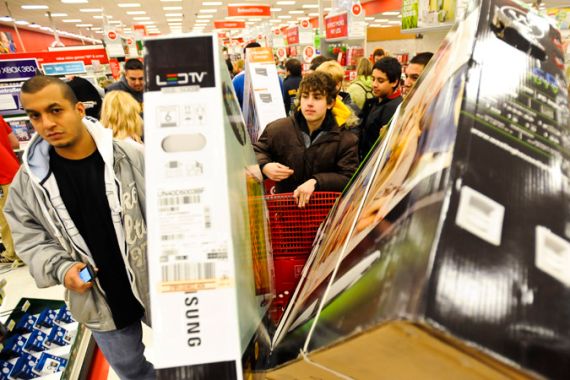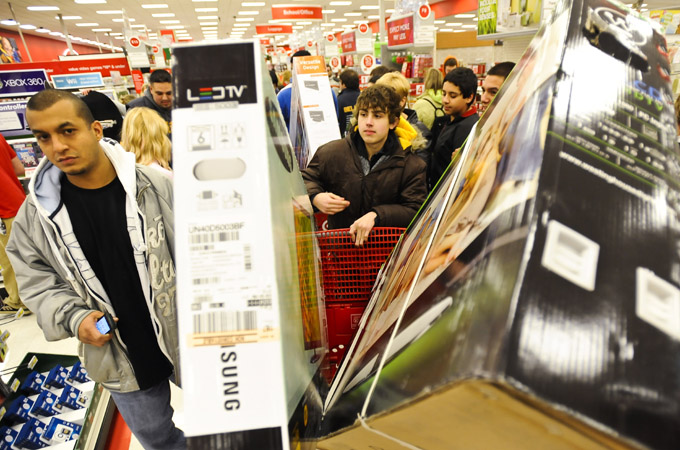‘Black Friday was blacker than we knew’
The Black Friday shopping spree was more about consumer desperation than about consumer confidence.

 |
| The massive Black Friday weekend spending rush is actually more of a negative sign, says the author [EPA] |
We all saw the shopocalpyse, as Reverend Billy of the Church of Stop Shopping calls it, on Black Friday. The big story became a shopper pepper-spraying others, and then a shot being fired. Not in most of the news: Occupy protesters in Oklahoma arrested at a Walmart for challenging blind consumerism.
That was the immediate news. The big story came a day later, calling this year’s shopping surge the biggest ever, up 30 per cent.
Keep reading
list of 4 itemsShip that caused deadly Baltimore Key bridge collapse towed to port
‘Why should we vote?’ India’s jute workers blame politicians for woes
California farmworkers cheer new housing in town scarred by mass shooting
Wow.
This news was viewed as a sign of consumer confidence that, with an earlier government report on a new wave of optimism released a week earlier, sent markets up.
But, as is so often the case, figures like these are designed more to foster public perceptions, not report truth. I have been following these numbers ever since making the film In Debt We Trust in 2006 and find them invariably misleading, perhaps by design.
First there is the good news in reports like this one on Bloomberg that get picked up widely: “Black Friday sales increased 6.6 per cent to the largest amount ever as US consumers shrugged off 9 per cent unemployment and went shopping”.
“Consumers spent $11.4bn”, ShopperTrak said in a statement in November. Foot traffic rose 5.1 per cent on Black Friday, according to the Chicago-based research firm.
“This is the largest year-over-year gain in ShopperTrak’s National Retail Sales Estimate for Black Friday since the 8.3 per cent increase we saw between 2007 and 2006,” ShopperTrak founder Bill Martin said in the statement.
Soon, the “big fact” of alleged economic success establishes itself in the public mind through pickup and constant reinforcement in every media, outlet.
It takes a while for reality to intrude. The story is one more Wall Street fraud on Main Street on many levels.
First, who benefits from this annual ritual? Are consumers really getting the buys of their lives?
Not really, reported the New York Times, on the basis of a study by an artificial intelligence expert at the University of Washington who studied pricing over many years and found Black Friday sales are not the lowest. “The bottom line is, Black Friday is for the retailers to go from the red into the black,” Oren Etzioni said. “It’s not really for people to get great deals on the most popular products.”
So much for the myth about deep discounts or deference to the almighty consumers whose “confidence” is supposedly being sought! (Bear in mind that word “confidence” can be used in another context as in “confidence game” or “being conned”.)
Who was doing the most shopping? People who could afford it! The China Daily reported at least one big discount mall outside of New York City where most of the shoppers were Chinese tourists. They believed the hype – in part because prices are higher in China.
In line with the boom in their economy, they spent almost twice as much overseas as people from other countries. There were 802,000 Chinese travellers in the US in 2010. There were more than a million this year.
What about the retailers? Are they in hog heaven?
Not necessarily.
First, they spend more to open stores early, and also on their pricey ad blitzes. So their costs of selling go way up while their profit margins go down because of deep discounting.
Second, the credit card companies, which are already soaking customers, take a large cut which is why the retail industry is suing the Federal Reserve Banks to lower the cut they are allowed. They say it is too high even as credit card charges are up.
The retailers are now denouncing the banksters, claiming they are being hurt by their gouging. Can we trust the numbers they are projecting?
The Financial Times – published in London – investigated these questions and the alleged 30 per cent hike, concluding that “Black Friday Sales Fail to Dispel Retail Gloom”. (Unlike, many US press outlets, they are not dependent on retailers’ ads, which tend to skew coverage.)
FT reports: “The number was an antidote to darkening economic clouds in Europe – and the optimistic analysis was that it signaled an increase in momentum that will lift consumer spending beyond the modest, inflation-enhanced rate at which it has grown so far this year.”
But there is also a gloomier interpretation: “that short-lived, deep discounts are the only things that can encourage cash-strapped consumers to spend and they will close up their wallets once the bargains have gone”.
It turns out that, overall, retail profits were buoyed not by the shopping of bargain hunters among the 99 per cent, but the acquisition of luxury items by the 1 per cent whose incomes have been rising.
Celebrity Paris Hilton is a poster girl for this excess. She bought herself a new Ferrari for a few hundred thousand dollars and boasted to friends and media supplicants. One columnist invoked the memory of Marie Antoinette with a disgusted, “off with her head”.
The retail markets – like society itself – is structured along class lines, and guess which class is the most welcome?
To stay popular with consumers, stores play down the key role played by so-called “upscale” consumers they covet the most.
The relatively low-wage retail workers – often just hired for the season – are definitely not in the 1 per cent. They are often used and abused, as one friend recounted: “My sister has a seasonal job at Walmart (obviously out of desperation) and had to work a horrid 11:30 PM-11:30 AM shift … she has two kids to take care of (they had to overnight with grandparents, but of course my sister had to pick them up and resume taking care of them with no sleep herself)”.
She reported that after the first couple hours, “Walmart was dead and she found it pointless to be there”. The infusion of these temporary workers led unemployment numbers to go up in November, but when the season is over, their jobs will be as well.
|
“The infusion of these temporary workers led unemployment numbers to go up in November, but when the season is over, so will be their jobs.” |
These are among the reasons that economists in the know don’t buy into the hype.
David Semmens, US economist at Standard Chartered, told the FT, “We expect that the aggression of the discounts brought shoppers out in force but this will take away from their shopping in December… The strength of the bounce is encouraging but we doubt it can be sustained.”
We won’t know the real figures until the day after Christmas when VISA and Master Card report on their earnings. In years past, they have deflated the impact of a media-hyped Black Friday “bounce” with words like “disappointing”.
But even they won’t have the final word because, after Christmas, the returns start with many consumers bringing back products they know they can’t afford to keep.
Aaron Krowne, of the must-read ML-implode.com website, looked closely at the claim that sales were up 30 per cent:
Could the situation possibly be 30 per cent better than last year?
Well, let’s go down the checklist of how such massively-increased spending might be possible:
A) consumers have 30 per cent more money?
B) consumers simply borrowed the difference (via credit cards)?
C) consumers simply moved their holiday spending forward to the “Black Friday” weekend and will spend less later?
(A) is most assuredly not the answer. Tax withholding numbers for this year have been anaemic and do not show any meaningful increase. Remember that people are simply not earning more if their withholdings tax payments are not going up; so this data point pretty much precludes an increase in income.
As far as explanation (B), increased use of credit cards, the data we have so far suggests “no”. Consumer credit has actually been meaningfully down this year. Now, it could have spiked up massively since the last release of the Fed’s consumer debt data, but I doubt this accounts for a majority of the 30 per cent, given the secular trend here.
That leaves (C) – consumers simply moving their spending to the “Black Friday weekend” in a panicked rush to pick up as many deals as possible. By process of elimination, this is most likely. It also makes intuitive sense given the long-run reality of consumers whose wages are decreasing (the withholdings taxes show the overall amount; whereas the median is actually falling) and who are borrowing less on an ongoing basis.
Thus, the massive Black Friday Weekend spending rush is actually more of a negative sign; consumers are more desperate than ever for the deals and will pepper-spray each other in a Walmart to get them.
So there you go: Another case study of how news is turned inside out, and a big economic story in which millions take part is distorted by superficial reporting intended to encourage more shopping, with many in our media looking for every silver lining in our economic misery that they can find.
News Dissector Danny Schechter covers the Occupy movement on his News Dissector blog. He made the film Plunder, about financial crime on Wall Street.
Follow Danny Schechter on Twitter.
The views expressed in this article are the author’s own and do not necessarily reflect Al Jazeera’s editorial policy.
